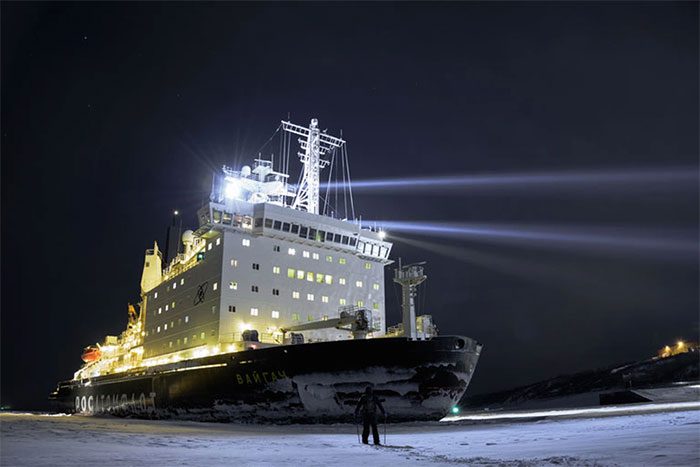Rosatom, the Russian atomic energy company, has unveiled a new nuclear reactor designed to be equipped on future icebreakers, enabling Russia to navigate through frozen maritime routes.
Moscow hopes that this technology will help develop the “Northern Sea Route”, connecting Europe (EU) with Asia, especially as it has been deprived of much of the EU market due to the impacts of the conflict in Ukraine.
Russia is asserting itself more in the Arctic region. Rosatom has announced that a new reactor is aimed at equipping nuclear-powered icebreakers in the future, which can operate continuously and traverse vast frozen maritime routes.
This is a crucial issue for Moscow’s Arctic ambitions, which seeks to transform the region into a trade route to Asia.

Russia is currently the only country in the world with a fleet of nuclear-powered icebreakers. (Photo: Meteo de neiges).
Nuclear-powered icebreakers are better suited for the Northern Sea Route due to their energy requirements and limited refueling capabilities.
“The RITM-200 reactor is part of the power system for all modern icebreakers,” said Vladislav Paikov, Deputy General Director of ZiO-Podolsk, a subsidiary of Rosatom.
He stated that this type of reactor is much lighter, smaller, and more powerful than older generations.
The new icebreaker, named Chkotka, is set to begin operations in 2026. The vessel will be adapted to navigate both maritime and river routes.
The Arctic: A Strategic Area for Moscow
A new reactor allows Russia to accelerate its development in the Arctic, a region deemed essential for exporting hydrocarbons to Asia.
The conquest of the Arctic is particularly appealing to Moscow as it provides an alternative solution to sanctions following the conflict in Ukraine, which has caused the country to lose much of its European market.
Russia hopes to assert the Northern Sea Route linking Europe to Asia, capitalizing on the melting ice due to global warming. In the future, it aims to compete with the Suez Canal, located in Eastern Egypt.
The country plans to build infrastructure to transport 150 million tons of goods via this maritime route by 2030. Furthermore, in early October, Russia announced the passage of the first ship from China through this Northern Sea Route.
For its part, Gazprom announced in November that it had delivered liquefied natural gas (LNG) to China for the first time via this maritime route.
The Russian company expressed its satisfaction, stating that using this maritime route allows for a significant reduction in the shipping time of LNG to Asia-Pacific countries.
For many years, Russia has been building port infrastructure, installing liquefied natural gas systems, and assembling a large fleet of icebreakers. However, navigating in the harsh Arctic conditions remains a significant challenge, and currently, this route is still far from being able to replace the Suez Canal.
Militarization of the Region
Developments are progressing from the Russian side, especially at the military level. Russia shares its presence in the region with Western countries such as the United States, Canada, and Northern Europe.
Therefore, even amid the ongoing conflict in Ukraine, Russia continues to strengthen its capabilities in the Arctic by reopening or modernizing Soviet-era bases and airfields.
Malte Humpert, founder of the Arctic Institute in the U.S., stated: “Russia has also deployed S300 and S400 missile systems, expanded runways to accommodate aircraft capable of carrying nuclear bombs, and built modern radar systems.”
Last August, the Northern Fleet, responsible for the Arctic, conducted military exercises involving over 8,000 soldiers and several submarines.
Admiral Rob Bauer, head of NATO’s military committee, noted: “The increasing competition and militarization in the Arctic region, particularly from Russia, is concerning. We must remain vigilant and prepare for surprises.”




















































